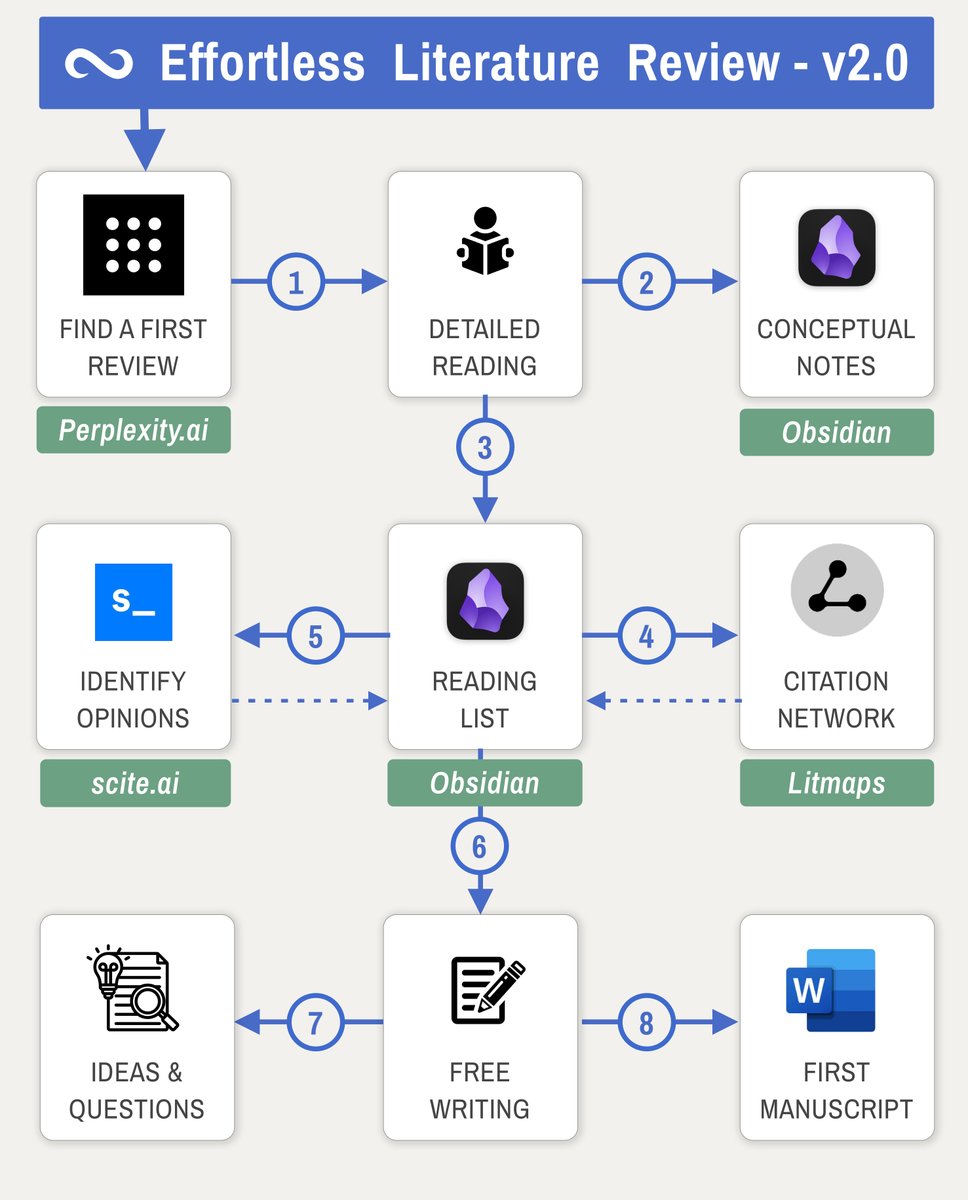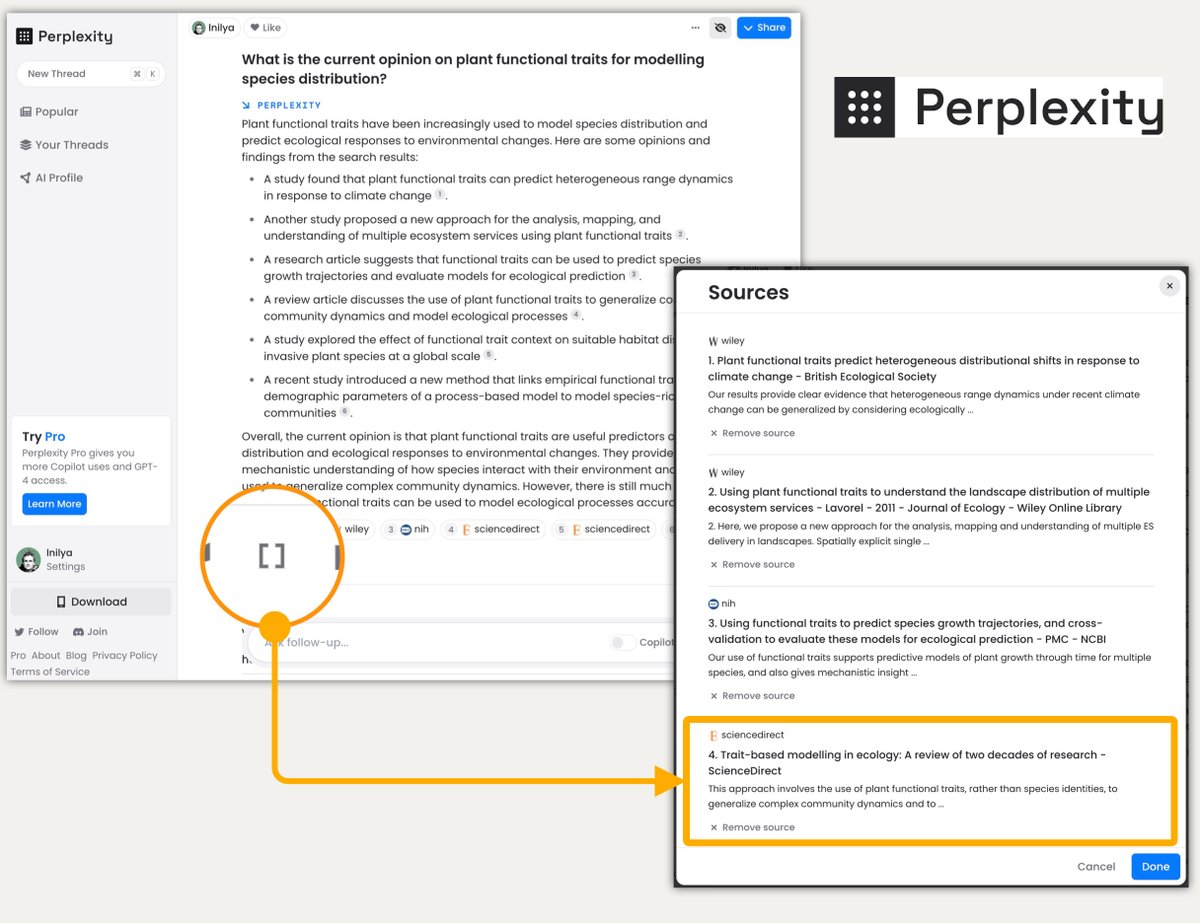Here is my newest workflow for an Effortless Literature Review.
It uses @perplexity_ai, @scite, @LitmapsApp, @obsdmd and @teampaperpal.
Tutorial with detailed examples & all the tools:
(Updated with new AI tools)
👇
It uses @perplexity_ai, @scite, @LitmapsApp, @obsdmd and @teampaperpal.
Tutorial with detailed examples & all the tools:
(Updated with new AI tools)
👇

@perplexity_ai @scite @LitmapsApp @obsdmd @teampaperpal The first step is to find a "gateway" paper.
We will use it to get an overview of our topic.
Ideally it has many REFERENCES for us to dig deeper.
And it has many CITATIONS (which we can identify with @LitmapsApp)
The best type is therefore a popular REVIEW paper!
We will use it to get an overview of our topic.
Ideally it has many REFERENCES for us to dig deeper.
And it has many CITATIONS (which we can identify with @LitmapsApp)
The best type is therefore a popular REVIEW paper!

@perplexity_ai @scite @LitmapsApp @obsdmd @teampaperpal 1. @perplexity_ai is a perfect academic search engine
Ask questions in plain english to start learning about your topic.
The [ ] button shows the sources in a popup.
Here is a paper titled: "...A review of two decades of research...".
That's what we were looking for!
Ask questions in plain english to start learning about your topic.
The [ ] button shows the sources in a popup.
Here is a paper titled: "...A review of two decades of research...".
That's what we were looking for!

@perplexity_ai @scite @LitmapsApp @obsdmd @teampaperpal Collecting all papers before reading them quickly overwhelms me.
Instead I start reading the first review but SLOWLY and CAREFULLY.
This is called a VERTICAL strategy.
To build knowledge think in concepts, not papers. For every CONCEPT you find, make a note and link.
Instead I start reading the first review but SLOWLY and CAREFULLY.
This is called a VERTICAL strategy.
To build knowledge think in concepts, not papers. For every CONCEPT you find, make a note and link.

@perplexity_ai @scite @LitmapsApp @obsdmd @teampaperpal Notes for me are synonymous with @obsdmd
It's free, private, fast, versatlie (plugins) and almost bug-free.
If you have never worked with @obsdmd, here is a one image introduction.
You can sign up for my free 8-day course on Obsidian (link in bio) notes.
It's free, private, fast, versatlie (plugins) and almost bug-free.
If you have never worked with @obsdmd, here is a one image introduction.
You can sign up for my free 8-day course on Obsidian (link in bio) notes.

@perplexity_ai @scite @LitmapsApp @obsdmd @teampaperpal Review papers will often present CONFLICTING OPINIONS on a topic.
e.g. The highlight in this paper talks about 3 camps.
Collect these papers into a READING LIST.
But don't just collect, write down WHY you want to read it.
This will help you to decide what to read next.
e.g. The highlight in this paper talks about 3 camps.
Collect these papers into a READING LIST.
But don't just collect, write down WHY you want to read it.
This will help you to decide what to read next.

@perplexity_ai @scite @LitmapsApp @obsdmd @teampaperpal There is a neat trick to find a reference from a paper quickly using @LitmapsApp
You don't even need an account.
You don't even need an account.
https://twitter.com/Artifexx/status/1644959708736897024
@perplexity_ai @scite @LitmapsApp @obsdmd @teampaperpal This method will give you REFERENCES (i.e. everything before this paper), but you are also interested in CITATIONS (i.e. everything after this paper)
This is what @LitmapsApp is for.
Let's create a collection of the 4 papers we have so far and find related ones.
🎥
This is what @LitmapsApp is for.
Let's create a collection of the 4 papers we have so far and find related ones.
🎥
@perplexity_ai @scite @LitmapsApp @obsdmd @teampaperpal You can do the above with a free @LitmapsApp account.
If you are only looking for CITATIONS (future), you will need a premium account.
(Video shows how to use it)
IMPORTANT: Be selective when adding papers to your reading list.
My rule of thumb: Keep it under 10 papers.
If you are only looking for CITATIONS (future), you will need a premium account.
(Video shows how to use it)
IMPORTANT: Be selective when adding papers to your reading list.
My rule of thumb: Keep it under 10 papers.
@perplexity_ai @scite @LitmapsApp @obsdmd @teampaperpal Litmaps can visualize your collection in a game changing visual way.
Location in graph tells you how recent a paper is and how many citations it has.
That means: Impactuful papers are at the top right (many citations & recent).
(Big circles signify reviews).
Location in graph tells you how recent a paper is and how many citations it has.
That means: Impactuful papers are at the top right (many citations & recent).
(Big circles signify reviews).

@perplexity_ai @scite @LitmapsApp @obsdmd @teampaperpal Instead of BROADENING you can also go DEEPER.
This is what @scite is for.
Search for a paper that presents an argument.
Set the citation types filter to "contrasting".
These are papers that DON'T support the argument.
Now you can learn about BOTH SIDES of an argument.
This is what @scite is for.
Search for a paper that presents an argument.
Set the citation types filter to "contrasting".
These are papers that DON'T support the argument.
Now you can learn about BOTH SIDES of an argument.

@perplexity_ai @scite @LitmapsApp @obsdmd @teampaperpal 6. Write short outlines every 5-10 papers.
While it feels counter-productive, it is crucial to write short outlines.
- You develop an argument
- You link papers and concepts together in your notes.
- You create drafts for your publication
I find 30 mins every few days enough.
While it feels counter-productive, it is crucial to write short outlines.
- You develop an argument
- You link papers and concepts together in your notes.
- You create drafts for your publication
I find 30 mins every few days enough.

@perplexity_ai @scite @LitmapsApp @obsdmd @teampaperpal 7. Ideas & Questions
A problem for novel scientists is identifying relevant RESEARCH QUESTIONs.
Group your thoughts on a topic, relevant papers and concepts in a question note!
(Papers often explicitely point them out.)
Expand more developed questions into separate notes.
A problem for novel scientists is identifying relevant RESEARCH QUESTIONs.
Group your thoughts on a topic, relevant papers and concepts in a question note!
(Papers often explicitely point them out.)
Expand more developed questions into separate notes.

@perplexity_ai @scite @LitmapsApp @obsdmd @teampaperpal 8. Writing your manuscript
Collect all your Outlines, papers and questions to have the raw materials to write a first draft.
I make a few grammatical mistakes and need more experience in academic writing - to help with that @teampaperpal is a great:
Collect all your Outlines, papers and questions to have the raw materials to write a first draft.
I make a few grammatical mistakes and need more experience in academic writing - to help with that @teampaperpal is a great:
https://twitter.com/Artifexx/status/1661301332446179330
@perplexity_ai @scite @LitmapsApp @obsdmd @teampaperpal Summary
1. @perplexity_ai finds reviews from plain text questions.
2. Make detailed notes on CONCEPTS, not papers.
3. Note WHY you want to read something, in your @obsdmd list.
4/5. Use @scite to go deeper, @LitmapsApp to go broader.
6. Make free text outlines every 5-10 papers.
1. @perplexity_ai finds reviews from plain text questions.
2. Make detailed notes on CONCEPTS, not papers.
3. Note WHY you want to read something, in your @obsdmd list.
4/5. Use @scite to go deeper, @LitmapsApp to go broader.
6. Make free text outlines every 5-10 papers.

@perplexity_ai @scite @LitmapsApp @obsdmd @teampaperpal If there is enough interest in the community, I will organize another webinar!
Please leave your email, to receive an exclusive discount, when the date is set.
Follow this tweet:
Please leave your email, to receive an exclusive discount, when the date is set.
Follow this tweet:
https://twitter.com/Artifexx/status/1670022490725433345
• • •
Missing some Tweet in this thread? You can try to
force a refresh




















